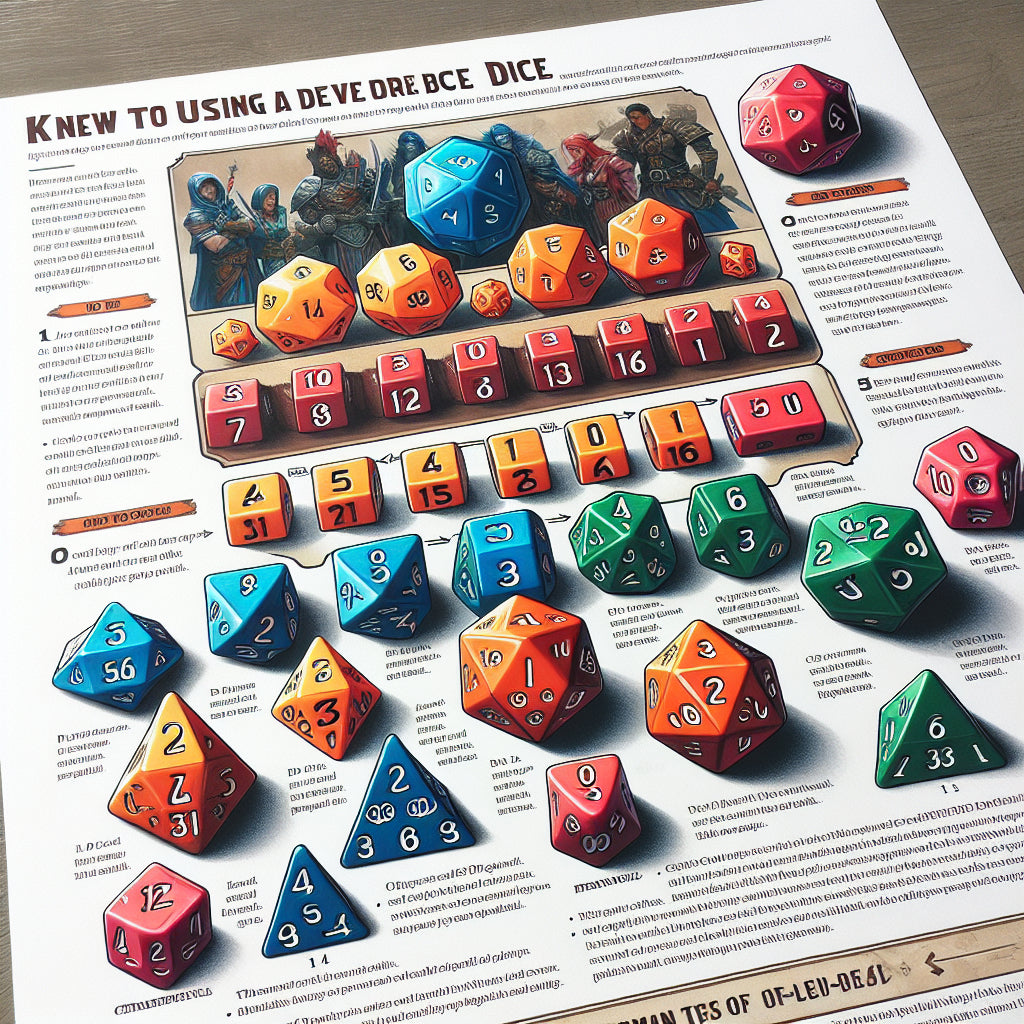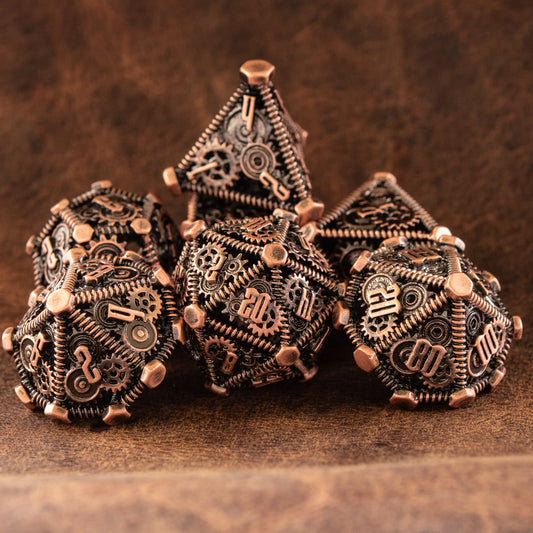How to Use DnD Dice: A Comprehensive Guide
Introduction
Dungeons & Dragons (D&D) is a game that thrives on imagination, strategy, and a bit of luck. Central to this experience is the use of dice, which injects an element of randomness and excitement into the gameplay. Understanding how to use DnD dice is crucial for both new and seasoned players. In this guide, we'll delve into the mechanics of D&D dice, the different types of dice used, and how they influence gameplay.
Types of DnD Dice
Dungeons & Dragons utilizes a variety of polyhedral dice, each with a specific purpose. Here's an overview of the different types of dice and their shapes:
- d4 (Four-Sided Die): Shaped like a pyramid, the d4 is typically used for small weapon damage and certain spell effects.
- d6 (Six-Sided Die): The most familiar die, often used for weapon damage, ability modifiers, and various skill checks.
- d8 (Eight-Sided Die): Used for moderate weapon damage and some spell effects.
- d10 (Ten-Sided Die): Commonly used for determining percentages and for weapon or spell damage.
- d12 (Twelve-Sided Die): Used for high weapon damage and some specific class features.
- d20 (Twenty-Sided Die): The most iconic D&D die, used for attack rolls, saving throws, and skill checks.
- d100 (Percentile Die): Used for determining percentages, often rolled in conjunction with a d10.
Each type of die has a unique shape, making them easily distinguishable. Here's a quick visual guide to help you identify each type:
- d4: Triangular pyramid
- d6: Cube
- d8: Octahedron
- d10: Pentagonal trapezohedron
- d12: Dodecahedron
- d20: Icosahedron
- d100: Two d10s (one marked in tens, the other in units)
Understanding Dice Notation
Dice notation in D&D is a shorthand way of describing which dice to roll and how many. The notation is typically written as XdY + Z, where:
- X is the number of dice to roll.
- dY indicates the type of die (e.g., d6 for a six-sided die).
- + Z is any additional modifier to add to the roll.
For example, 3d6 + 2 means you roll three six-sided dice and add 2 to the total. Here are some common notations:
- 1d4: Roll one four-sided die.
- 2d8: Roll two eight-sided dice.
- 1d20 + 5: Roll one twenty-sided die and add 5 to the result.
Dice Roll Mechanics
When to Roll Dice in D&D
Dice rolls in D&D are used to determine the outcomes of various actions and events. Here are common scenarios where dice rolls are necessary:
- Attacks: Rolling to see if an attack hits and how much damage it deals.
- Skill Checks: Determining the success of actions like climbing, sneaking, or persuading.
- Saving Throws: Checking if a character can avoid or reduce the effects of harmful spells or traps.
Examples of How Dice Rolls Influence Gameplay Outcomes
- Attacks: A player rolls a d20 to see if their attack hits the target. If the roll, plus any modifiers, meets or exceeds the target's Armor Class (AC), the attack hits. The player then rolls the appropriate dice for damage (e.g., 1d8 for a longsword).
- Skill Checks: To climb a steep cliff, a player might roll a d20 and add their Athletics skill modifier. If the total meets or exceeds the Difficulty Class (DC) set by the Dungeon Master (DM), the climb is successful.
- Saving Throws: When a character is targeted by a fireball spell, they might roll a d20 and add their Dexterity saving throw modifier to avoid taking full damage. If the roll meets or exceeds the spell's DC, they take half damage instead.
Where to Find DnD Dice
Finding the perfect set of D&D dice is part of the fun. Here are some places to look:
- Local Game Stores and Hobby Shops: These stores often carry a wide variety of dice sets and may offer the chance to see and feel the dice before purchasing.
- Online Retailers and Marketplaces: Websites like Amazon, eBay, and specialty retailers like Dice Envy and Chessex offer a vast selection of dice sets. Online shopping provides convenience and access to a broader range of options.
- Specialty Stores for Custom and Premium Dice Sets: For unique and personalized dice, specialty stores like Kraken Dice and Die Hard Dice offer custom and premium sets made from materials like metal, stone, and resin.
By understanding how to use DnD dice and where to find them, you can enhance your Dungeons & Dragons experience and add an extra layer of excitement to your gameplay. Whether you're rolling for a critical hit or a crucial skill check, the right dice can make all the difference.
How to Use DnD Dice: A Comprehensive Guide
Advanced Dice Rolling Techniques
As you delve deeper into the world of Dungeons & Dragons (D&D), you'll encounter more complex scenarios that require advanced dice rolling techniques. Mastering these techniques can significantly enhance your gameplay experience and provide exciting moments during your adventures.
Advantage and Disadvantage Rolls
In D&D, certain situations provide your character with either an advantage or a disadvantage. These mechanics are designed to reflect favorable or unfavorable conditions affecting your actions.
- Advantage: When you have an advantage, you roll two d20s and take the higher result. This increases your chances of success.
- Disadvantage: Conversely, when you have a disadvantage, you roll two d20s and take the lower result. This reflects a higher likelihood of failure.
For example, if your character is trying to sneak past a guard while it's raining heavily (providing cover noise), the Dungeon Master (DM) might grant you an advantage on your Stealth check. On the other hand, if you are attempting the same action while wearing noisy armor, you might roll with a disadvantage.
Critical Hits and Misses
Critical hits and misses add an extra layer of excitement to combat in D&D.
- Critical Hits: When you roll a natural 20 on a d20 attack roll, you score a critical hit. This means you roll double the damage dice for your attack, significantly increasing the potential damage.
- Critical Misses: Rolling a natural 1 on a d20 attack roll is a critical miss, often resulting in a failure so spectacular that it can have unintended consequences, as determined by the DM.
Using Multiple Dice for Complex Actions
Certain spells, abilities, and actions in D&D require rolling multiple dice. Understanding how to use these rolls effectively can be crucial in high-stakes situations.
- Spell Damage: Spells like Fireball or Lightning Bolt require rolling multiple dice to determine damage. For example, a Fireball spell might require rolling 8d6 to calculate the total damage.
- Healing Spells: Similarly, healing spells like Cure Wounds might require rolling multiple dice to determine how much health is restored to a character.
Customizing Your Dice
Personalizing your D&D dice can add a unique flair to your gameplay. There are numerous options available for customizing your dice sets to match your character's theme or your personal aesthetic preferences.
Options for Personalized and Themed Dice Sets
Custom dice sets can be tailored to fit specific characters, campaigns, or personal tastes. You can find dice with unique designs, colors, and engravings that reflect your character's personality or the theme of your campaign.
Materials and Aesthetics
Dice come in various materials, each offering different aesthetics and tactile experiences:
- Plastic: Lightweight and affordable, plastic dice are available in a wide range of colors and designs.
- Metal: Heavier and more durable, metal dice offer a premium feel and are often intricately designed.
- Stone: Made from materials like marble or jade, stone dice are unique and beautiful but can be fragile.
- Wood: Wooden dice provide a natural, rustic look and can be customized with different stains and finishes.
- Resin: Resin dice can be customized with colors, glitters, and inclusions, offering a translucent or glittery appearance.
- Glass: Glass dice are visually stunning but fragile, often used more for display than gameplay.
Pros and Cons of Different Dice Materials
- Plastic: Affordable and widely available, but can wear down over time.
- Metal: Durable and satisfying to roll, but can damage surfaces if not used carefully.
- Stone: Unique and beautiful, but prone to chipping or cracking.
- Wood: Lightweight and customizable, but may wear down with heavy use.
- Resin: Durable and aesthetically versatile, but more expensive than plastic.
- Glass: Visually appealing, but fragile and impractical for regular gameplay.
Digital vs. Physical Dice
In the digital age, players have the option to use digital dice rollers in addition to traditional physical dice. Each option has its advantages and disadvantages.
Advantages and Disadvantages of Digital Dice Rollers
-
Advantages:
- Convenience: Easily accessible on various devices, ideal for online play.
- Consistency: Ensures truly random rolls without the risk of biased results.
- Tracking: Some apps can track rolls and results, simplifying the gameplay process.
-
Disadvantages:
- Lack of Tactile Experience: Missing the physical act of rolling dice, which can be part of the fun.
- Technical Issues: Reliance on technology can lead to issues if devices malfunction or lose power.
Popular Digital Dice Rolling Apps and Tools
- D&D Beyond: Integrated within the platform, offering seamless gameplay.
- Roll20: Popular for online campaigns, includes a dice roller feature.
- Dice Roller Apps: Various apps available on mobile devices, such as RPG Simple Dice and CritDice.
Comparing the Experience of Digital vs. Physical Dice
While digital dice offer convenience and consistency, many players prefer the tactile and immersive experience of rolling physical dice. Ultimately, the choice depends on personal preference and the context of your gameplay.
Using DnD Dice in Gameplay
Understanding how to effectively use D&D dice during gameplay is essential for a smooth and enjoyable experience. Here are some practical tips:
Step-by-Step Guide on How to Roll Dice
- Identify the Required Dice: Determine which dice you need to roll based on the action you're taking.
- Roll the Dice: Shake the dice in your hand and roll them onto a flat surface.
- Read the Results: Note the numbers on the top faces of the dice.
- Apply Modifiers: Add or subtract any relevant modifiers to the roll.
- Interpret the Outcome: Use the total to determine the success or failure of your action.
Interpreting Results and Applying Them to the Game
Once you've rolled the dice and calculated the total, compare the result to the target number (e.g., an enemy's Armor Class or a skill check Difficulty Class). The outcome will dictate what happens next in the game.
Examples of Dice Rolls in Different Gameplay Situations
- Combat: Rolling a d20 for an attack roll, followed by rolling damage dice if the attack hits.
- Skill Checks: Rolling a d20 and adding skill modifiers to determine success in tasks like climbing or persuading.
- Saving Throws: Rolling a d20 and adding the relevant ability modifier to avoid or mitigate damage from spells or traps.
Conclusion
In this comprehensive guide, we've covered the essential aspects of how to use D&D dice, from basic mechanics to advanced techniques and customization options. By mastering the use of D&D dice, you can enhance your gameplay experience and bring more excitement to your adventures.
Summarize Key Points Covered in the Article
- Types of DnD Dice: Understanding the different dice and their uses.
- Dice Notation: Learning how to read and interpret dice rolls.
- Dice Roll Mechanics: Knowing when and how to roll dice in various scenarios.
- Advanced Techniques: Utilizing advantage, disadvantage, and critical hits.
- Customizing Dice: Exploring personalized and themed dice sets.
- Digital vs. Physical Dice: Weighing the pros and cons of each option.
- Using Dice in Gameplay: Practical tips for rolling and interpreting dice results.
Encourage Readers to Practice and Enjoy Using Their DnD Dice
Whether you're a new player or a seasoned veteran, practicing with your D&D dice and experimenting with different techniques will make your gameplay more enjoyable and immersive.
Call-to-Action
Share this article with your fellow adventurers, join a D&D group to put your dice-rolling skills to the test, and explore related content to further enhance your understanding of Dungeons & Dragons. May your rolls be ever in your favor!
By following these guidelines and embracing the randomness and excitement that D&D dice bring to the game, you'll be well-prepared for any challenge that comes your way in the fantastical world of Dungeons & Dragons.






